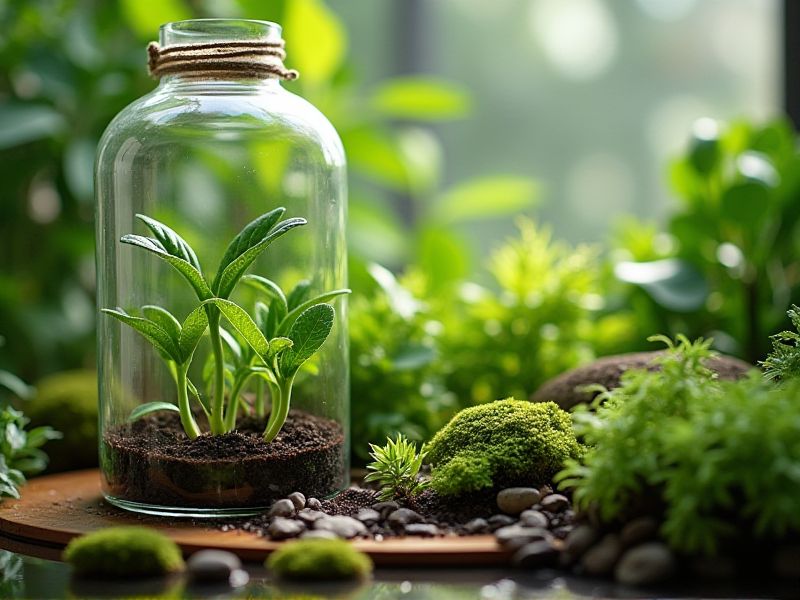
Terrariums are ideal environments for cultivating small plants, which thrive in their enclosed ecosystems. Popular choices include fittonia, known for its striking veined leaves, and moss varieties that create lush ground cover. Pothos is another favorite, with its resilient nature and trailing vines that enhance vertical growth. Unlike larger houseplants, these small species require minimal space and limited light, making them perfect for indoor settings. To maintain their health, ensure proper humidity and avoid overwatering, so your mini-garden flourishes beautifully.
List of some Small plants that thrive in terrariums
- Baby Tears (Soleirolia soleirolii)
- Spider Fern (Asplenium bulbiferum)
- Polka Dot Plant (Hypoestes phyllostachya)
- Pilea (Pilea involucrata)
- Nerve Plant (Fittonia albivenis)
- Creeping Fig (Ficus pumila)
- Peperomia (Peperomia obtusifolia)
- Miniature African Violet (Saintpaulia)
- Air Plant (Tillandsia)
- Moss (Bryophyta)
Important things about Small plants that thrive in terrariums
Low Light Requirements
Small plants that thrive in terrariums and require low light include species like **Ferns**, **Moss**, and **Snake Plants**. These plants naturally thrive in the shaded understories of forests, making them perfect for low-light environments. **Ferns** such as the **Boston Fern** or **Maidenhair Fern** offer lush greenery, while **Moss** contributes a soft, vibrant carpet to the terrarium floor. Incorporating **Snake Plants**, known for their air-purifying qualities, ensures a healthy atmosphere while requiring minimal light, making them ideal for your indoor garden.
High Humidity Tolerance
Small plants that thrive in terrariums often possess high humidity tolerance, making them ideal for enclosed environments where moisture levels can be elevated. Common species include Fittonia, also known as nerve plant, which features vibrant, patterned leaves and prefers consistently moist soil. Another excellent choice is the maidenhair fern, famous for its delicate fronds that flourish in humid conditions and contribute a lush aesthetic to your terrarium. To maintain optimal growth, ensure adequate drainage while providing a closed environment that fosters humidity, allowing these plants to flourish beautifully.
Small Leaf Size
Small-leafed plants are ideal candidates for thriving in terrariums due to their compact growth habits and minimal light requirements. Species such as **Fittonia** and **Peperomia** not only adapt well to humid environments but also bring vibrant colors and textures to your miniature ecosystem. Their small leaf size allows for dense planting, maximizing space while creating a lush appearance. When caring for these plants, ensure proper drainage and humidity levels to support their delicate foliage and encourage healthy growth.
Compact Growth Habit
Small plants that thrive in terrariums often feature a compact growth habit, making them ideal for limited spaces. Varieties such as *Fittonia*, commonly known as nerve plants, and *Sphagnum moss* provide lush greenery without overwhelming your setup. *Peperomia* species, known for their varied leaf shapes and colors, also adapt well to humid environments, ensuring a vibrant display. By selecting these resilient plants, you can create a thriving miniature ecosystem that enhances any indoor setting.
Tolerance To Varying Temperatures
Small plants that thrive in terrariums often exhibit remarkable tolerance to varying temperatures, making them ideal for indoor environments. Species like the Fittonia, or nerve plant, can adapt well to temperatures ranging from 60degF to 80degF, thriving in both warmer and cooler conditions. Meanwhile, the various types of moss, such as sheet moss and cushion moss, not only endure changes in humidity but also display resilience to fluctuating temperatures, enhancing the microclimate within your terrarium. By creating a stable environment with proper ventilation, you can maximize the health and growth of these temperature-tolerant plants.
Minimal Root System
Small plants that thrive in terrariums often feature minimal root systems, making them ideal for contained environments. Examples include the delicate fittonia, known for its stunning leaf variegation and low light tolerance, and the resilient moss species, which requires minimal care while adding lush greenery. Other popular choices for terrarium setups are miniature ferns and sedums, both of which adapt well to high humidity and compact spaces. By selecting these plants, you can create a vibrant, low-maintenance ecosystem within your terrarium.
Pest Resistance
Small plants that thrive in terrariums often exhibit natural pest resistance traits, making them ideal for enclosed ecosystems. Varieties such as the Peperomia and the Spider Plant have evolved mechanisms to deter common pests, ensuring their survival in humid environments. You can select these resilient species to create a low-maintenance habitat that minimizes the need for chemical interventions. By incorporating pest-resistant plants, your terrarium can flourish while maintaining a balanced and vibrant microenvironment.
Slow Growth Rate
Small plants with a slow growth rate are ideal for terrariums, as they create a lush, vibrant environment without overwhelming the space. Species such as *Sphagnum moss*, *Ferns*, and *Peperomia* not only maintain their compact size but also thrive in the humidity-rich atmosphere typical of terrariums. These plants require minimal light, making them perfect for low-light conditions and for hobbyists who appreciate low-maintenance greenery. You can enjoy a beautifully balanced ecosystem while facilitating the longevity and health of these slow-growing plants in your terrarium.
Ability To Recycle Air
Small plants that thrive in terrariums, such as **ferns**, **mosses**, and **air plants** (Tillandsia), demonstrate a remarkable ability to recycle air effectively. Through photosynthesis, these plants absorb carbon dioxide while releasing oxygen, contributing to a healthier microenvironment within the enclosed ecosystem of a terrarium. The moisture retention in the moss and soil creates a humid atmosphere that aids in the natural filtration of air pollutants. Incorporating these plants into your terrarium not only enhances its aesthetic appeal but also promotes a sustainable and self-sustaining air quality.
Compatibility With Other Terrarium Plants
When creating a terrarium, choosing compatible small plants is essential for ensuring a healthy ecosystem. Some great options include ferns, moss, and miniature orchids, which thrive in humid environments and low light. You can also consider fittonia and cryptanthus for their vibrant colors and unique textures, adding visual interest to your setup. Grouping these plants together not only enhances the aesthetic appeal but also fosters a balanced microclimate, allowing your terrarium to flourish.
